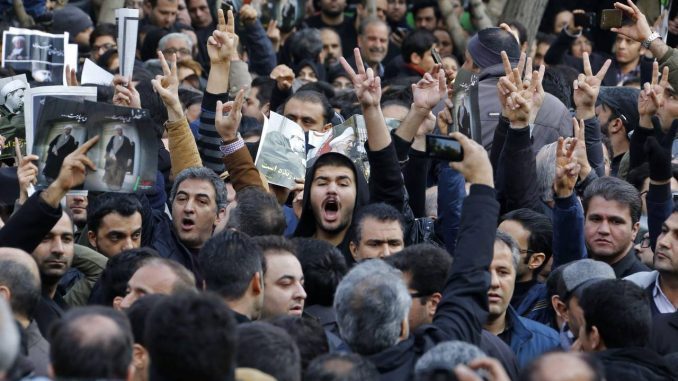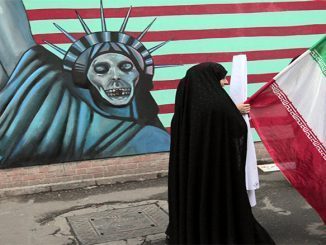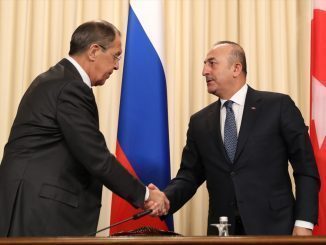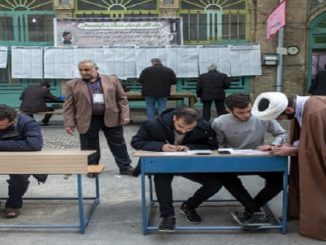
The burial ceremony of Hashemi Rafsanjani became a prelude for the divide and factional feuding among Iran regime different bands, as reformists’ supporters used the chance to make demonstrations against the current ruling hardliners.
Rafsanjani, a pragmatist considered Iran’s second most powerful political figure for much of the Islamic Republic’s history, died in hospital in north Tehran on Sunday at the age of 82.
Rafsanjani was a founding member of Iran’s 1979 Islamic revolution that ended the Shah role and brought the clerics’ regime to power. He was a prominent politician after the revolution, and a close person to the former supreme leader Khomeini
When Khomeini died in 1989, Rafsanjani played an instrumental role in the appointment of Ayatollah Ali Khamenei as the current supreme leader.
He served as president for two consecutive terms from 1989 to 1997.
During his leadership, Iran went through an extraordinary transformation as the country focused on post-war construction and industrial revival.
After his presidency, political rivals, jealous of his grip on the economy, seized on his support for reformists and labeled him an “aristocrat,” a “capitalist” and a supporter of “American Islam”, and the rift grew between him and Khamenei.
Rafsanjani’s funeral and reformists’ move
Mourners packed the streets of downtown Tehran for the funeral procession of former President Akbar Hashemi Rafsanjani. The crowd was estimated by Tehran’s governor at up to 2.5 million people.
Former President Mohammad Khatami, the founder of Iran’s reform movement and the most popular political figure, was banned from attending the funeral. The regime has long feared Mr. Khatami’s popularity and sought to sideline him by banning media from broadcasting or printing his picture and denying him permission to leave the country.
Many people had responded to a call from former President Mohammad Khatami to attend the funeral as a show of support for the opposition reform movement.
It was a rare public demonstration since the 2009 unrest that rocked the country in the aftermath of a contested presidential election.
Many were chanting opposition slogans, and others carried placards emphasizing Rafsanjani’s links to the moderate and reformist camps.
“Long live Khatami, Long Live Rouhani. Hashemi, your soul is at peace!” said one banner.
Crowds of men and women, young and old, lifted their fists in the air and chanted, “Ya Hossein, Mir Hossein,” and “Our demand is clear, end the house arrest,” referring to Messrs. Mir Hossein Mousavi and Mehdi Karroubi, the leaders of the opposition Green Movement who have been under house arrest for six years.
Some of the chants were aimed at Russia, Iran’s ally in the Syrian conflict. Video clips on social media showed mourners shouting “Death to Russia” and “the Russian Embassy is the den of espionage,” as they passed the embassy’s complex in the heart of Tehran. People also called for the release of hunger strikers in Iranian prisons.
In an apparent jab at Mr. Khamenei and hardline clerics they chanted, “The only real clerics were Hashemi [Rafsanjani] and Montazeri.” Ayatollah Hussein-Ali Montazeri was a dissident cleric who fell out of favor with the regime and died under house arrest.
On Iranian social media the funeral has been the number one topic with many opposition supporters using the hashtag #weallgathered to indicate their support and sympathy.
People have been posting photos and videos emphasizing the number of opposition supporters out on the streets and showing the opposition slogans which state TV has been trying to obscure.
Desire to change
“For more than two decades people of Iran have used every occasion to not so discretely send a message to Khamenei and his allies that the status quo is untenable,” said Abbas Milani, the director of Iranian studies at Stanford University. “The more a figure stands up to the status quo, the more popular he or she becomes in Iran.”
“Hashemi’s death is a great worry to us,” said Leili Farhang, a 26-year-old university graduate, who emphasized that she was unemployed “like many of my generation.” She and her friends had showed up in front of the Tehran University campus “to pay respect to a man who respected us.”
Saeed Razavi Faghih, a political analyst from Tehran told BBC Persian on Tuesday that the supporters of the Green Movement were mourning the moderate Rafsanjani of post-2009 while regime supporters were mourning the revolutionary man.
A woman who had attended the funeral with a group of her friends in support of the opposition but didn’t want her name to be published said, “The desire to change and reform has not died and whenever there is an opportunity it will resurface and we will raise our voice.”
Regime tries to cover the demonstrations
In the teeming streets, scenes clashed incongruously. At one point, Ayatollah Khamenei could be heard through loudspeakers saying prayers for Mr. Rafsanjani while protesters chanted opposition slogans. Some wore green wristbands, the color of the opposition, and flashed victory signs.
State television muted the sound from the funeral. Iranians also reported that the internet was slow and both land lines and mobile lines were jammed, in what appeared to be an attempt to prevent news of the protests from spreading.
At one stage state television played loud music over its live broadcast of the event in order to drown out opposition slogans being chanted by the crowd.
As the official funeral eulogies were relayed to the crowds on the streets, they responded with and shouts of: “Microphone is yours, voice of justice is ours! Shame on you, Shame on State TV!”
government supporters have also taken to Twitter to play down the opposition showing at the funeral, accusing them of political opportunism.
“A huge army came out of love of the Supreme Leader,” wrote a cleric called Sheikh Reza. “While a few foot soldiers came with their cameras to show off.”
It took hours for the body to arrive at the South Tehran mausoleum, because of “the millions that have come out to honor the ayatollah,” Khabarfori, an Iranian online news channel, said on the Telegram messaging app.
Inside the mausoleum, state television showed, a marching band played the national anthem, after which Mr. Rafsanjani’s coffin was placed next to Mr. Khomeini’s, as planned.
These demonstrations show that huge rift between the different parts of the Iranian society, and the state of dissatisfaction among the Iranian civilians. They also show that the pressure has reached a critical point, and it may be waiting for the suitable time to be unleashed.



